About Polystrate Fossils
I received an email asking some common questions about polystrate fossils. To my dismay, I realized I had never actually answered these questions in writing anywhere.
Polystrate fossils are fossils which are buried in the sedimentary record cutting through more than one sedimentary layer. The rock layers are called ‘strata’ and the fossil cuts through more than one, hence the name ‘poly’ for many and ‘strate’ for the strata the fossil cuts through. Polystrate fossils are found literally all over the world.
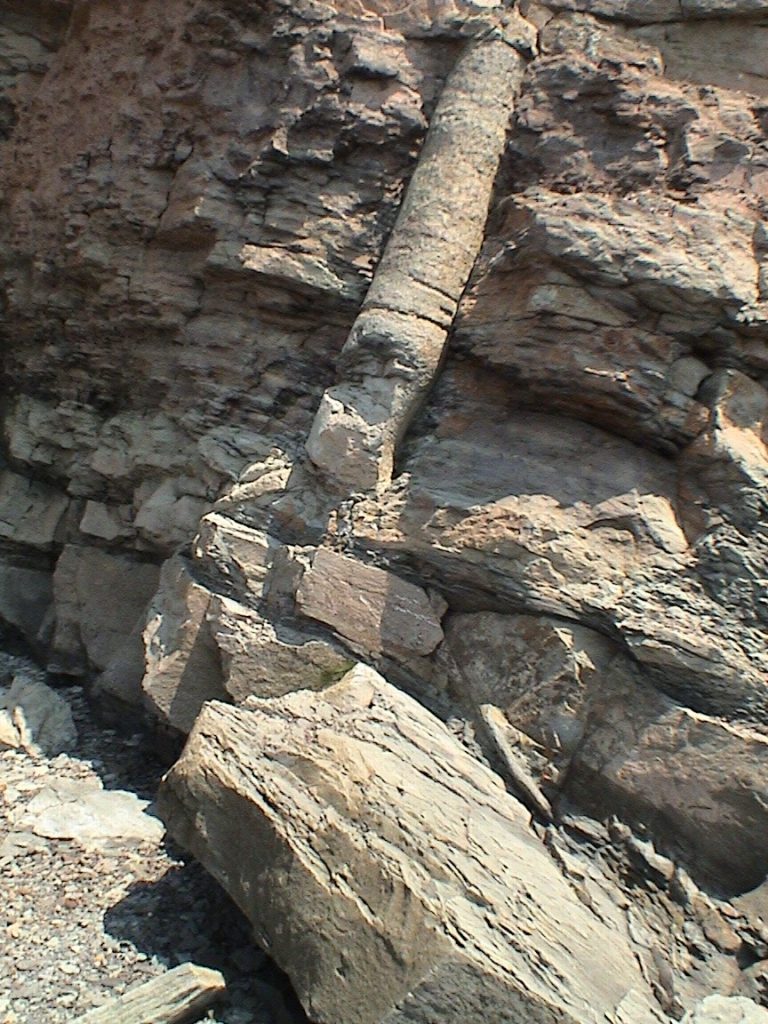
Polystrate fossils create an impossible situation for advocates of deep time. Clearly the rock layers have not been laid down over millions of years as the top of the trunk would have rotted away long before the layers were deposited. Yet the father of deep time, Sir Charles Lyell, still advocated that these plants were buried where they grew (‘in situ’) in order to bolster his ‘new history’ of deep time he invented to replace the Biblical story of a global flood. A gentleman by the name of Paul wrote in some questions regarding polystrate fossils:
Dear Mr. Juby,
I am writing with a question about polystrate lycopod fossils. I was tipped off that I should ask you about these because I saw an image on creation.com of one such specimen which had been attributed to you. I have searched through a bit of creationist literature and have thus far not been able to find any decent scientific sources to refute the skeptic’s claim that these polystrate tree fossils must have been buried in situ because they have intact root structures that grew into the surrounding strata. I have seen a couple of creation articles claim otherwise, but I didn’t find any suitable references to back up this claim. On the contrary, I was provided by a skeptic with a reference to a very old book from the 19th century that purports to describe them thus: “One of the most remarkable peculiarities of the stigmaria-rooted trees was the very regular arrangement of their roots, which … divide at equal distances … giving off, on all sides, an immense number of rootlets, stretching into the beds around, in a manner which shows that these must have been soft sand and mud at the time when these roots and rootlets spread through them … the roots found in them were not drifted, but grew in their present positions;”
Do your own observations contradict this description? Is this description even referring to the same thing as what creationists are referring to when they talk about polystrate trees? Wading through this mess is proving difficult, so I would be glad to receive any clarification or help you might be able to provide.
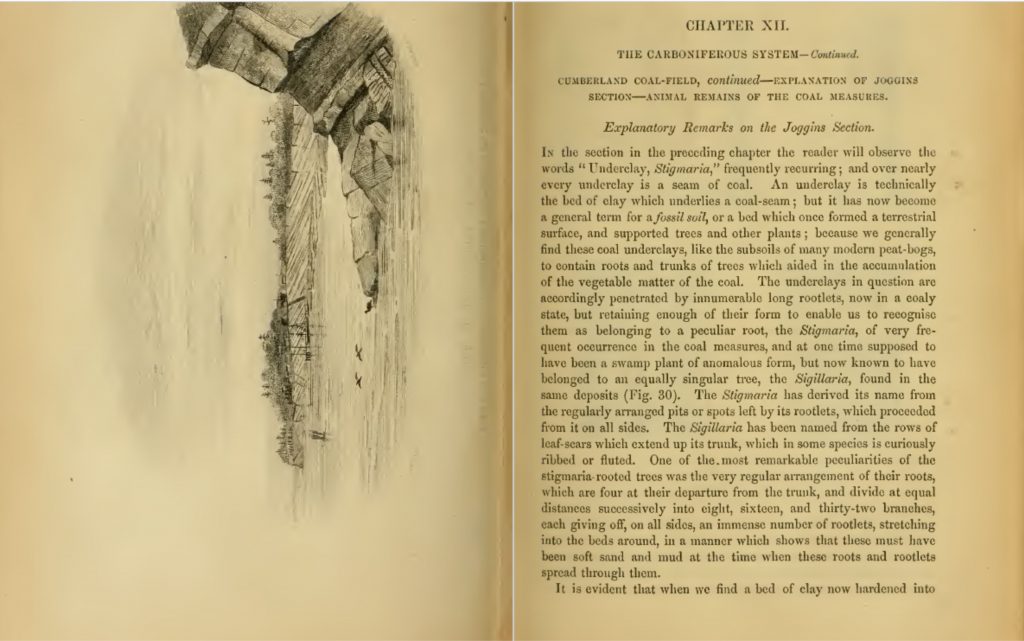
Excellent questions that I hear fairly regularly. It is true that there is often intact roots found attached to these fossil stumps. I have photos of dozens of such cases. Lyell’s argument (as well as Dawson and the modern day deep time advocates) is that the intact roots are evidence that they were buried where they grew. The fact that in general, the stumps with intact roots tend to be found on the same clay bedding plane further bolstered the claim that the bedding plane was the original forest floor which was also buried in place along with the trunks.
In the photo below you can see a chunk of one of the roots (commonly called stigmaria) and you can see the pock marks around the outside, each of which radiates a rootlet. The rootlets are visible in the counter slab as black marks as the roots, rootlets and plants have all now turned into coal.

It should be noted that these plants are still around today as the Lepidodendron. Today those plants grow to maybe 16 inches tall, yet in the fossil record they are found up to 120 feet tall. The roots and the trunks are actually hollow, although the trunks had a pithy core which was displaced and infilled with sediments when the trunk was buried.
The stumps are sometimes found with the rootlets and/or roots stripped from the trunks. Clear signs that the trunks were ripped up by water, transported a distance and buried, refuting the idea of ‘in situ’ burial. But let us remember that polystrate fossils are a global phenomenon that includes far more than just the lowly Lycopods. For example, polystrate fossil coprolite (fossil poo!) has been reported at the public fossil dig sites in the Green River formation of Wyoming. Solid wood polystrate fossil tree trunks have been found in multiple places like Yellowstone National Park, or Axel Heiberg Island in the Canadian arctic. Interestingly, the ‘fossil’ stumps of Axel Heiberg Island aren’t fossilized – you can cut them with a hand saw and burn them. I have samples of this wood in my museum collection and these samples were included in the Carbon 14 testing conducted by Thomas and Nelson(1) and low and behold, there was lots of C14 found in them. But I digress. In the entire, exhaustive report by the Geological Survey Of Canada(2) on the alleged ‘in situ’ fossil forests of Axel Heiberg, you are hard pressed to find any stumps with intact roots! You will find one stump with roots extending a whopping 3 feet to a root end which has clearly been broken off. Yet these stumps are referred to consistently as buried ‘in situ.’ This is what is typically found in these alleged ‘in situ fossil forests’ claimed by advocates of deep time, so clearly their definition of ‘in situ’ and ‘intact roots and root systems’ are quite a bit different from mine!
Furthermore, the claim that the trunks of Joggins are all rooted in clay horizons (as implied by Dawson in Acadian Geology and reiterated by many deep time advocates) is demonstrably false. At the Joggins fossil cliffs the roots will be found in just about any form of deposit: clays, sandstones, shales, even coal seams. The polystrate Lycopods at the Wartburg, Tennessee coal mine were ‘rooted’ in the same horizon which was a coal seam. The polystrate trunks found in the Grande Cache coal mine (which we’ll look at closely in just a moment) were also rooted in the same horizon, a coal seam.
But let’s give the skeptics the benefit of the doubt: let’s assume that all of the stumps have intact, complex root systems in the same horizons. The roots of multiple trunks sharing the same horizon is actually not good evidence for in situ burial. Especially when one takes a closer look at those roots and their alleged ‘forest floor.’
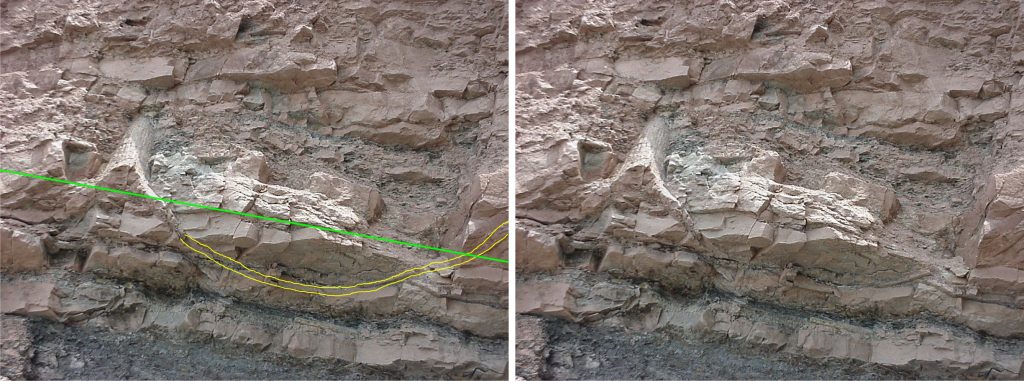
Taking a look at the dramatic Lycopod stump, I’ve highlighted the very long root attached to the stump, complete with rootlets. Notice that the root descends from the stump, then ascends, bending upwards as if floating, and even coming up above what is claimed to be the forest floor horizon! This particular specimen has all the qualifications to meet the definition of ‘in situ’ put forward by the deep time advocates: It has intact roots and rootlets, it shares the same horizon with other stumps and roots, and it was rooted in what is interpreted as a clay horizon. Yet it is unlikely that the roots would have grown in this way – the roots grow down, not up. However, if this stump had been dislodged and transported by water, the roots would have been buoyed up in the sediments and water, thus we have an excellent explanation for this bizarre phenomenon. But – it gets better. The roots of that stump are actually entangled with the roots of a second stump which is underneath the first. The second stump is buried upside-down!
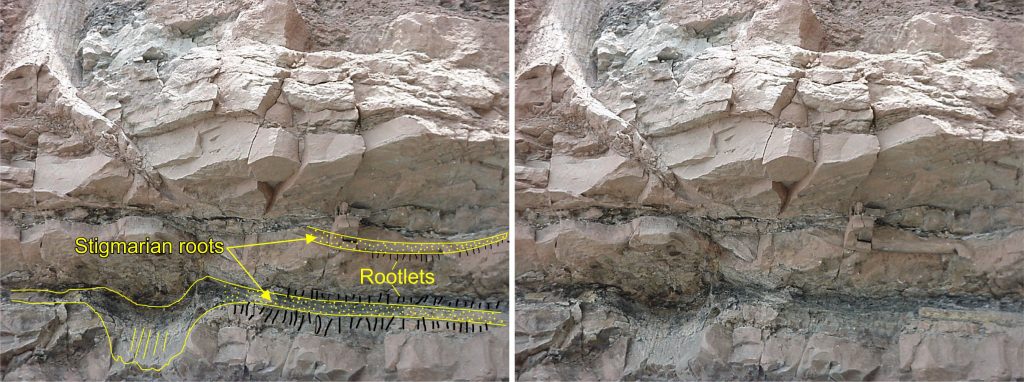
This second, inverted stump, also has all of the qualifications for the ‘in situ’ definition: intact roots and rootlets, sharing the same horizon with other stumps and roots, and it was rooted in what is interpreted as a clay horizon. But last I checked, plants don’t grown very well upside-down.
While not common at Joggins, I’d probably estimate about 1 in 100 of the polystrate Lycopods are buried upside-down. I am not the first, nor the only one to report these inverted stumps. Geologist John Mackay(3) has found some as well as Harold Coffin who documented some and provided photos of in his excellent book “Origin by Design.”(4)
When I visited the Grande Cache coal mine in 2010 to investigate the copious numbers of fossil dinosaur tracks found there, the young geologist and I made an unexpected discovery. The stratigraphic horizons are tilted up now from tectonic upheaval, almost to the vertical. We kept seeing these strange, star-shaped depressions in the layers.
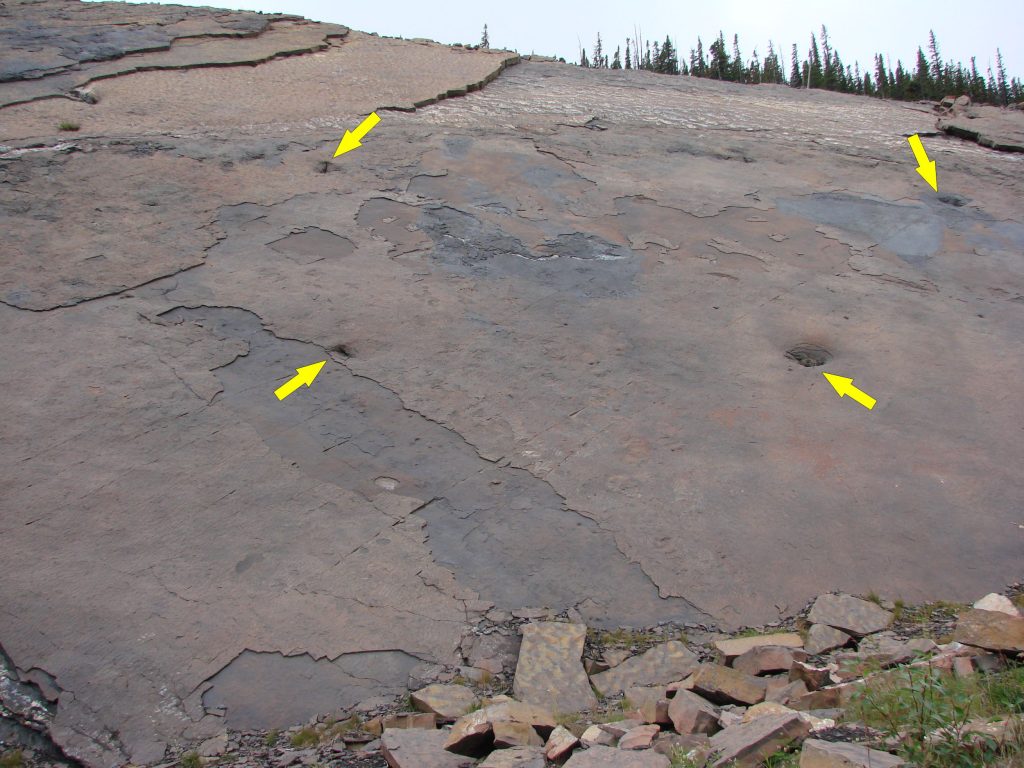
When we came across one at ground level, we were shocked to find that these were all coalified stumps buried upside-down with their roots coming up into the coal seam (which had been mined away) and the trunk itself going downwards, cutting polystrate through the layers containing the trails of dinosaur tracks.

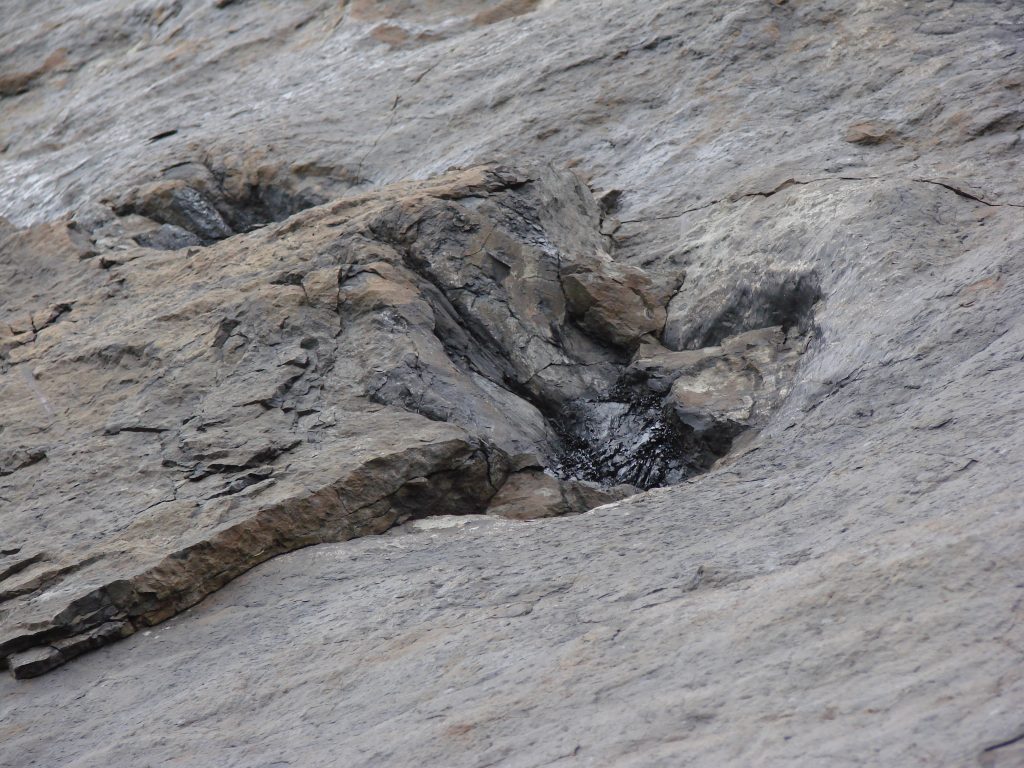
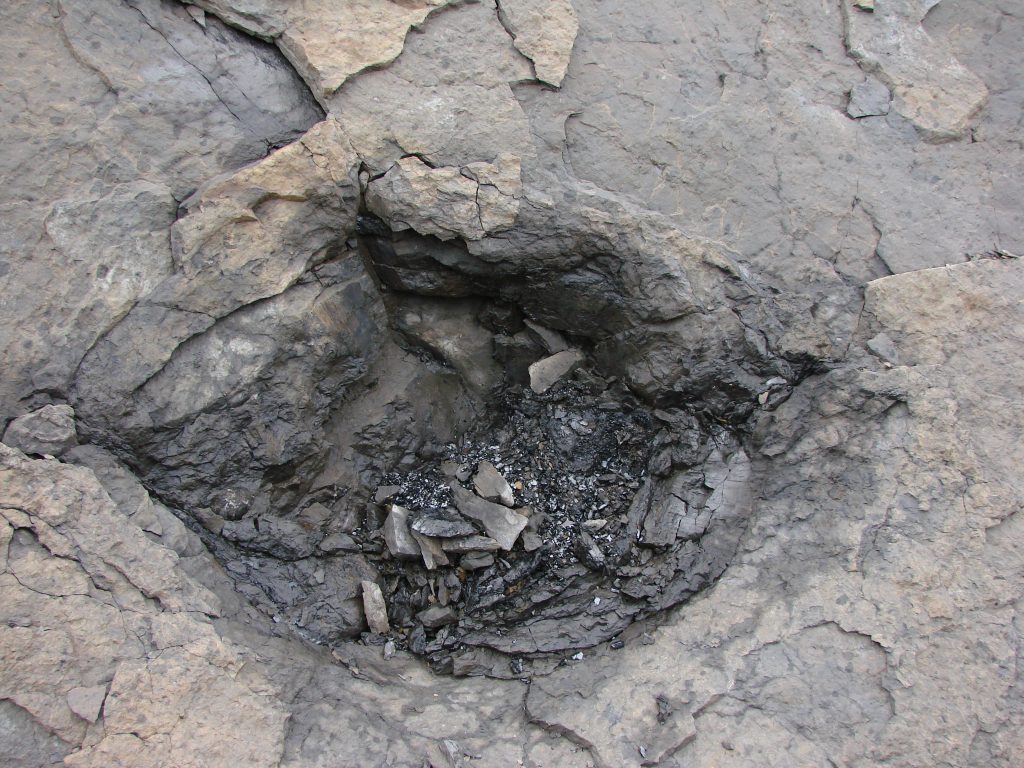
These stumps (the numbers of which I didn’t count – but as you can see were more than just a few) again fit the stipulations of the deep time advocates for interpreting these stumps as buried in situ: there were intact roots (though they have been removed in the mining operations) attached to the stumps and shared the same horizon with many other stumps. The only problem being, the trunks are all buried upside-down. Clearly these trunks weren’t buried where they grew. It’s also pretty clear that the multiple levels of dinosaur trails were not seasonal migrations as the stumps would have been sticking up from the sediments, upside down, for at least years while the sediments deposited every year for the dinosaurs to walk on. But I digress.
There is another significant argument to be made against deep time and the idea that these multiple horizons of fossil trunks were years of forest growth and burial. Take a look at this lycopod root:

This particular root is interesting for a few reasons. You can see the darker, differentially coloured sediments surrounding the root, as if the rootlets had clumped some soil surrounding the root when it was ripped up by water, transported and buried here. But this root, like all the others here, also tells a story of incredible pressures. The Lycopod roots were hollow and originally round. Notice the root has been squished vertically. The roots were very strong, hollow tubes and almost invariably have been crushed to failure. Although it’s difficult to see in the photo, the roots have not only been flattened vertically, they are actually split from the pressure on the top and bottom.
The sedimentary layers of Joggins total almost 20,000 vertical feet. You can walk miles of beach and because the layers have been tectonically tilted to the south (and then planed off flat across the top – see my CRSQ paper on these Planation surfaces(5)), you can examine thousands of vertical feet of sediments from the comfort of a stroll down the beach.

You’ll find roots throughout the thousands of feet which have all been compressed vertically. You’ll also find fossil logs which have been compressed to incredible levels, such as this one:
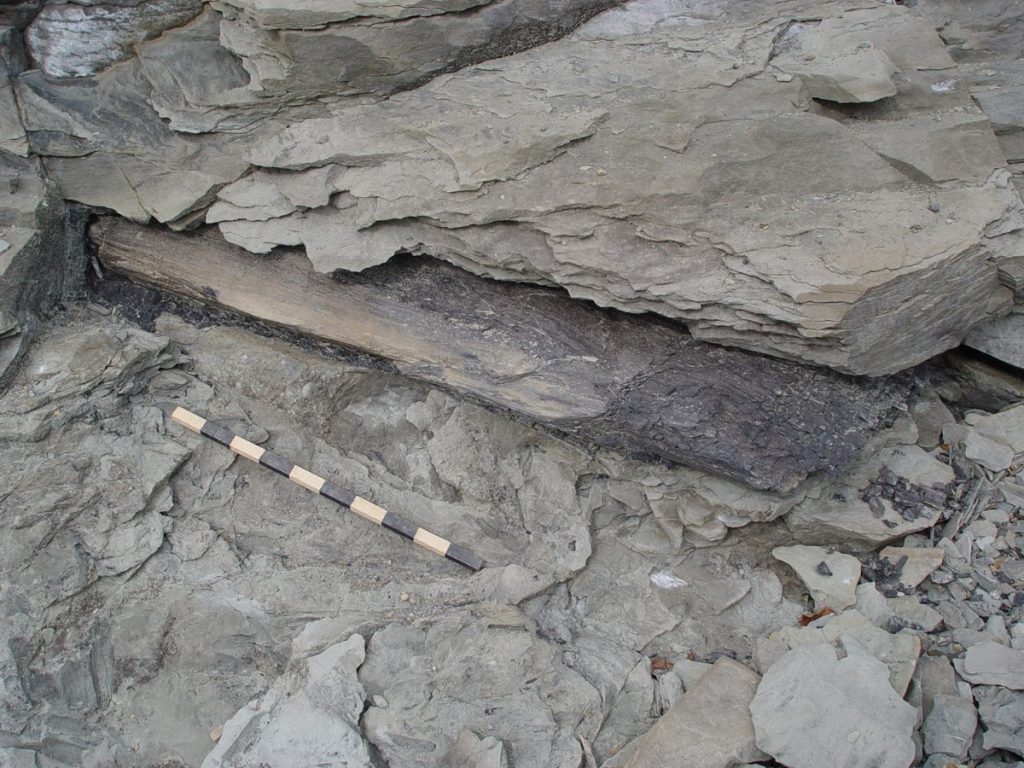
The pressures required to do this are astonishing. We can draw several, simple conclusions: 1) the trees and roots were still green when they were compressed. 2) the trees and roots had not rotted (they are preserved in pristine condition). 3) The trees had not yet petrified when they were compressed because simply put, you can’t compress a rock! 4) The Lycopod trunks and roots all show bending and compression which had to have happened while they were not yet turned to coal – they bent, instead of fracturing and disintegrating as hard and fragile coal would do. 5) The sediments the trees and Lycopods were buried in had not yet lithified (turned to solid rock) as the sediments themselves show compression and deformation along with the plants.
Everyone agrees that the compression was caused by the weight of the enormous overburden of sediments piled on top of the plants. In experiments conducted separately by myself and Vance Nelson (Creation Truth Ministries, Alberta, Canada) we were unable to deliver sufficient hydraulic pressures to mimic the compression we see in the fossil record. In my own experiment, I had pressures equivalent to hundreds of feet of overburden. So let’s play it safe with an unrealistically conservative number and say it requires a mere 300 feet of sediments to crush the Lycopodium tubular roots and the tree trunks. Starting at the bottom of the Joggins formation, we find crushed fossil logs. So a minimum of 300 feet of sediments need to be rapidly piled on top of the log before it rots, while it is still green and compressible, before it turns to stone, and before the sediments turn to stone. But in that 300 feet of overburden you will find many more crushed, petrified and coalified tree trunks and Lycopod roots – all of which also had to have been rapidly buried under a minimum of hundreds of feet of soft sediments before the plants rotted, while they were still green, before the plants turned to coal or stone, and before the sediments turned to solid rock.
But in that 300 feet of overburden sediments required to do this, you will find more crushed logs and Lycopod roots. Ad infinitum. You can put the entire ~20,000 vertical feet of sedimentary layers of the Joggins Formation into one, rapid burial event that accumulated so fast that the plants buried within were still green, had not rotted, had not turned to stone or coal, and the sediments had not yet had a chance to turn to solid rock.
Oh, and did I mention this is consistent with every formation containing polystrate fossils you find around the world?
What kind of event would rapidly bury millions of plants in tens of thousands of feet of sediments over a provincially sized area? I can assure you of one thing: whatever event that would be, we would call it a catastrophe, and on a global scale – not long and slow geological processes. Interestingly, that planation surface at the top of the cliffs is also a pertinent part of the big picture: the layers were eroded by huge volumes of extremely fast moving water. Everything about the Joggins formation in particular (but also attributable to every other polystrate fossil formation you’ll find) speaks of a huge, watery catastrophe of global proportions. I would contend it was the flood of Noah’s day. Yes, there is evidence for Noah’s flood. It’s all around you, and it’s profound and overwhelming.
Further reading: Chapter 13 “The Joggins Polystrate Fossils” in Rock Solid Answers, edited by Reed and Oard, Master Books, 2009: https://www.masterbooks.com/mwdownloads/download/link/id/307/
- Thomas & Nelson, Radiocarbon in Dinosaur and Other Fossils, CRSQ, Volume 51, No. 4, Spring 2015, pg 299
- Tertiary fossil forests of the Geodetic Hills, Axel Heiberg Island, Arctic Archipelago / edited by R. L. Christie and N. J. McMillan. GSC Bulletin 403 http://publications.gc.ca/site/eng/21087/publication.html
- Mackay, personal communication. Mackay has spent decades researching the Joggins Fossil Cliffs and polystrate fossils around the world.
- Coffin, Harold, Origin by Design, 1993, Hagerstown, Maryland Review and Herald Hagerstown, Maryland, pp. 117-133
- Juby, Ian, Massive Mountain Planation of the Eastern Canadian Seaboard, CRSQ, 2013. 49:287-295


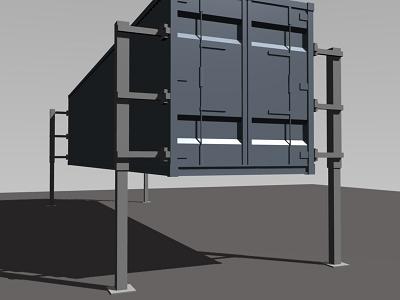

 an excellent book. Mike and John wanted to put together a book answering the common claims of old-earth, anti-creation advocates. Rock Solid Answers was the result. Geared for the layman, it is technical (it needs to be) but readable.
an excellent book. Mike and John wanted to put together a book answering the common claims of old-earth, anti-creation advocates. Rock Solid Answers was the result. Geared for the layman, it is technical (it needs to be) but readable. I have NO idea why – but it seems the past couple of months, I have been inundated with questions about mutations, information in the genetic code, etc… That subject seems to be the rage lately.
I have NO idea why – but it seems the past couple of months, I have been inundated with questions about mutations, information in the genetic code, etc… That subject seems to be the rage lately.




